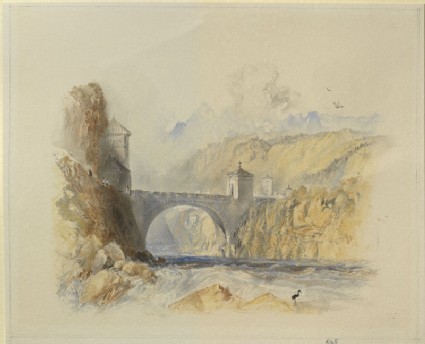Browse: 1470 objects
- Reference URL
Actions
Drawing of Turner's "Saint Maurice" William II Ward
-
Details
- Artist/maker
-
William II Ward (1829 - 1908)after Turner (Joseph Mallord William Turner) (1775 - 1851)
- Object type
- drawing
- Material and technique
- watercolour on wove paper
- Dimensions
- 221 x 271 mm
- Associated place
-
- Europe › Switzerland › Valais › Saint-Maurice › Saint-Maurice (subject)
- Inscription
- Recto, bottom, towards right, in graphite: R145
Verso:
just below centre, in ink: By William Ward / | Copied from Turner drawing in the National Gallery
top, just right of centre, in graphite: R145
top right, trimmed away, in graphite: [...]
just below, in graphite: R R/[erased] [the 'R/...' within a rectangular box]
just below, in graphite: & R/1/32
- Provenance
-
Presented by John Ruskin to the Ruskin Drawing School (University of Oxford), 1875; transferred from the Ruskin Drawing School to the Ashmolean Museum, c.1949.
- No. of items
- 1
- Accession no.
- WA.RS.RUD.145
-
Subject terms allocated by curators:
Subjects
-
References in which this object is cited include:
References
Ruskin, John, The Ruskin Art Collection at Oxford: Catalogue of the Rudimentary Series, in the Arrangement of 1873, ed. Robert Hewison (London: Lion and Unicorn Press, 1984), cat. Rudimentary no. 145, RUD.145
Ruskin, John, Instructions in Practice of Elementary Drawing, Arranged with Reference to the First Series of Examples in the Drawings Schools of the University of Oxford (n.p., [1872]), cat. Rudimentary no. 145
Ruskin, John, Instructions in the Preliminary Exercises Arranged for the Lower Drawing-School (London: Smith, Elder, 1872), cat. Rudimentary no. 145
Ruskin, John, Instructions in the Preliminary Exercise Arranged For the Lower Drawing-School (London: Spottiswoode, 1873), cat. Rudimentary no. 145
Ruskin, John, ‘Rudimentary Series 1878’, 1878, Oxford, Oxford University Archives, cat. Rudimentary no. 132
Ruskin, John, ‘The Ruskin Art Collection at Oxford: Catalogues, Notes and Instructions’, Edward T. Cook and Alexander Wedderburn, eds, The Works of John Ruskin: Library Edition, 39 (London: George Allen, 1903-1912), 21, cat. Rudimentary no. 145
Location
-
- Western Art Print Room
Position in Ruskin’s Collection
Ruskin's Catalogues
-
Ruskin's Rudimentary series, 3rd ed. (1872)
R|145} St. Maurice. Copy of Vignette by Turner. Consummate use of water-colour on white paper. W. Ward. -
Ruskin's Rudimentary series 4th ed. (1872)
R|145} St. Maurice. Copy of Vignette by Turner. Consummate use of water-colour on white paper. W. Ward. -
Ruskin's Rudimentary series, 5th ed. (1873)
R|145} St. Maurice. Copy of Vignette by Turner. Consummate use of water-colour on white paper. W. Ward. -
Ruskin's revision to the Rudimentary series (1878)
now 145 132.St. Maurice, a copy by M.r. Ward of the most beautiful of the vignettes to the Italy. Nothing is finer in the whole range of Turner’s works than the original drawing, and I should never end if I began talking about it. I should probably, nevertheless, have begun and not ended, if I were not brought to pause by my entire inability to find excuse for a fault which, unless I advised him of it, the student would probably not have found out, but which in honour I cannot conceal, that the Rhone runs the wrong way. It might indeed have been long before this audacity - for it is not an error - had been detected; for the railroad passes the R. scene in a tunnel, and not one traveller in a thousand ever sees either the bridge or the river; but before this record of one quite the greatest among the works of human art, I am bound to acknowledge whatever can be justly alleged against it. The facts are that, from the beginning to the end of his life, Turner’s object was never to give literal or geographical account of anything, but to perpetuate the mental impression he had himself received from it. That impression at St. Maurice had depended on the aspect of the bridge seen from this side and on the rapidity of the Massy river that rushed beneath it, but not in the least on the quarter of the compass to which its current was directed. He felt himself unable to express its power in looking down stream and chose therefore to represent the bridge behind it and the river in front. I do not justify this, but if Turner had always done right, his country and the world lon would long ago have known that he did, and there would have been no occasion for any author of Modern Painters.





